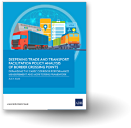Making trade happen! A quick look at the proposed WTO trade facilitation agreement
The World Trade Organization (WTO) is billing a global agreement on trade facilitation as the central issue for the upcoming Bali Ministerial in December. This is not a new issue, but this is the first time it has been elevated in this forum. As a result, we ask what exactly is this agreement all about and how much does it really matter for developing countries' trade flows?
What is the WTO Trade Facilitation Agreement?
Trade facilitation first made its way to the WTO agenda in 1996. But it was not until 2004 that negotiations towards a TFA formally launched as part of the Doha Development Agenda. As it exists today, the WTO Trade Facilitation Agreement (TFA) draft addresses the freedom of goods transit, trade-related fees and formalities, and transparency of trade regulations. It aims to provide a common framework that would govern customs clearance formalities and expedite the release of goods.
How can it benefit developing countries?
Developing countries in the WTO have struggled to plug into the dynamic Global Value Chains (GVCs) that have come to define the international commercial architecture. In large part, this has been the result of domestic productivity and logistical factors rather than the tariff barriers which have traditionally been the focus of WTO negotiations. The TFA seeks to address this disconnect by creating three important deliverables for developing countries that can address some of the roadblocks that the countries face.
1. A framework for unilateral reforms that can even out progress among regions and countries
Active reforms are underway in many countries. But while progress has been made in recent years, it has not been wide ranging. The World Bank's “Doing Business” 2013 Report tallied 212 trade facilitation reforms around the world over the past eight years. Due to these reforms, average time to export was reduced from 26.0 days in 2006 to 22.2 days today, and the average time to import was reduced from 30.4 days in 2006 to 25.0 days.
Additionally, regions vary in their ability to pursue reform. Figure 1 shows the number of reform measures arranged by regional grouping. The top reformers belong to Eastern Europe, Central Asia, the Middle East and North Africa, where 83% of countries have instituted at least one reform measure. 73% of economies in Latin America and the Caribbean had implemented least one reform measure.

Asia has faced some difficulty in instituting reforms as rapidly as other regions. In East Asia and the Pacific, only 63% of countries have implemented any reforms. In South Asia, it is only 50%. The majority of these reforms involved the introduction or improvement of electronic submission and processing of customs declarations.
2. Policies that can address the fragmentation of trade
Many of Asia's developing countries have relatively low tariff barriers and stable domestic economic structures. Yet they still struggle to diversify exports and plug into the region's dynamic GVCs. The TFA could unlock many of the hidden barriers that remain by both exposing the extent of problems with trade facilitation and also offering support to remove these bottlenecks to trade.
The sheer scope of benefits of this was noted in a speech earlier this year, WTO Director General Pascal Lamy noted that “Removing barriers to trade and cutting red tape in half, which is what a multilateral Trade Facilitation Agreement could deliver, could stimulate the $22 trillion world economy to the tune of $1 trillion.” This reminds us that tariff reduction alone will not result in the free flow of goods.
3. Smoothly operating supply chains that can help countries plug into global value chains
A large part of today's trade takes place within value chains. The fast and efficient customs and port procedures which are promoted under the TFA are essential to the smooth operation of these supply chains. Countries where goods can be imported and exported more quickly and more reliably are more likely to be able to link into regional and global production and distribution networks. This is important because it is through higher technology manufacturing production where the potential for technological transfer and moving up the value chain are present. The TFA can provide developing countries with both the incentive and also the guidance to make the domestic adjustments that will smooth the linkage process to GVCs.
Conclusions
A finalized TFA will be good for more than just the WTO's reputation. It can be an opportunity for developing countries to adjust the international trade system to more closely match their needs.
The first action developing countries can take to ensure this outcome is to articulate their trade facilitation priorities. This will enable negotiations to move forward in a way that benefits all participants.
A second action is to highlight the importance of a link between Aid for Trade and the TFA. This will help to address developing country concerns about limited domestic capacity to implement the agreement and to target donor funds properly.
Given the need for a win in the WTO and a desire to engage in GVCs by developing countries, a concerted effort to hammer out a meaningful WTO Trade Facilitation Agreement may prove an investment worth making.




